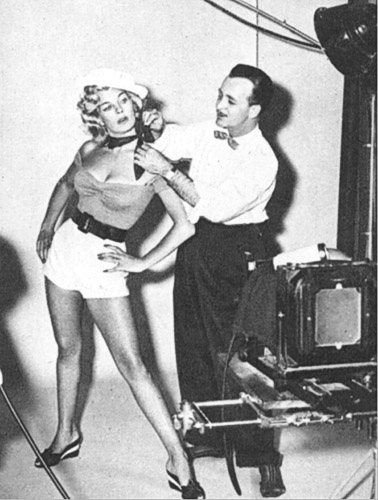
Hollywood glamour photographer Keith Bernard prepares for a photo session with model Corrine Calvet
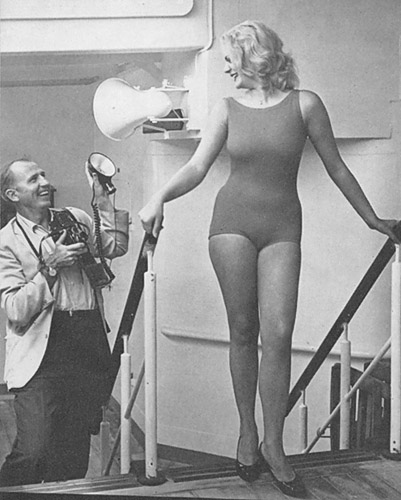
Miami photographer Bill Hamilton
Continuing on with my profiles of pin-up and glamour photographers of the 50s and 60s...

David M. Mills - It is indeed a rare privilege to be able to communicate directly with some of the great glamour photographers of the 1950s and 60s. A few of the photographers that I've previously had the pleasure of corresponding with are Peter and Alice Gowland and Bunny Yeager, but I've also recently had the honor of having several email conversations with David M. Mills and was able to obtain some additional biographical information from him for this website.
David M. Mills first opened his commercial photography studio in Hollywood in 1953, where he specialized in stock photography. His studio, called The Picture File, allowed him to be involved with many different types of photography, but one of the many genres in which he excelled was glamour photography. He sold numerous photographs of models and actresses to magazines and photo digests such as Art and Camera, Art Photography, Good Photography, Candid Photography, Salon Photography and Prize Winning Photography. By 1957, his outstanding glamour work was being featured alongside the other well known and respected photographers of the day (Peter Gowland, Andre de Dienes, Bruno Bernard, Peter James Samerjan, and Keith Bernard) in the book Best Photography from Trend Books. Three separate editions of Best Photography were published (in 1957, 1959, and 1961) and a portfolio of Mills' work was featured in every edition.

David Mills' exquisite shot of ballet dancer Roberta Launa appeared on the cover of the July 1954 issue of Art and Camera.

Mills' photograph of Sheree North was featured on the cover of the Sept. 1952 issue of Art and Camera.
Of Mr. Mills' many artistic nudes photographed in beautiful Southern California locations, some of his most well known are of the classic glamour and figure model Marguerite Empey (later known as Diane Webber, after her marriage to Joe Webber). Mills initially photographed her in his studio, but they later traveled to many locations in Southern California - on the beach in Malibu, near a beautiful waterfall in the mountains, and in the desert, and many of these photos were published in photography books and magazines throughout the 50s and 60s. An account of one of their excursions into the desert, written by Marguerite Empey, can be found here.
David M. Mills was born on Oct. 6, 1927 in Washington, DC. He went to the Signal Corps Photography School in Long Island, NY while in the army and became staff photographer for the Second Infantry Division at Fort Lewis, Washington. After the army, Mills attended the Fred Archer Photography School in Los Angeles for 2 years. From there he went into freelance photography for a three-year period and then finally opened his own studio in Hollywood.
The earliest nude study that I saw by David M. Mills appeared in a Good Photography book from 1951, so he was already producing beautiful glamour images at the astonishingly young age of 23 or 24! His work would continue to be featured regularly in those photography books throughout the 1950s and early 60s.
For camera equipment, Mills used a 4x5 Graphic View and a 4x5 Crown Graphic almost exclusively, as he liked the quality from the large negative and it was also more accepted by his commercial clients. He used Kodak Super XX film and did all of his own b&w darkroom work so that he could better control the quality of his prints. He relied on D-76 for his film developer, and after projecting the negative onto photographic paper using his Omega 4x5 enlarger, he developed the print in Kodak Dektol.
In addition to Diane Webber, some of the other dancers, actresses and models that Mills photographed include Sylvia Lewis (click here to see a Mills photo in Sylvia's gallery section), Sheree North, Roberta Launa, Betty Vicki, Kitty Rourke, June McCall, Shirley Kilpatrick, Jeanmarie Lussier, Marilyn Masters, Maureen Marlowe, Gloria West, Diana Elledge, Lou Ann Stamness, Virginia Rogers, Marilyn Wesley, Kitty Randall, Jolie Venette, Billie Nelson, Lorraine Gleason, Brigitte Baum, Vivian Maledy and Nancy Lewis. Though Mills mostly sold his photos to Art and Photography magazines, some of his work did appear in a few men's magazines of the late 50s and early 60s. Nine of his photos of Diane Webber were published in the third issue of Adam magazine (Jan. 1957) and a pictorial on Marilyn Wesley appeared in a 1959 issue of Spree magazine. Several more of his Diane Webber nudes were later published in Mosaic Annual magazine (1961), and a three page pictorial of Jeanmarie Lussier ("Go West, Jeune Fille!") was published in the May 1960 issue of Scamp magazine. In addition, David's photos of model Virginia Rogers appeared in the May and Sept. 1963 issues of Modern Man (in the Modern Art for Men gallery).
By 1965, David and his first wife Ursula had decided that a smaller town would be a better place to raise their two young children, so they closed the Hollywood studio and bought an existing portrait studio in a small town located 50 miles north of Sacramento (where their third child would later be born). After the move from Hollywood, all of David Mills' glamour work ceased. David Mills continued to run his portrait studio until 2004, when he decided to retire. Today, at age 91, David M. Mills is looking to market some of his great glamour work of the 1950s and a book of his photographs of Diane Webber has been published.
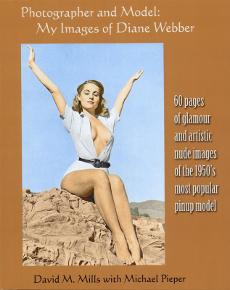
Update - Mr. Mills' book has been completed and will be sold on the Blurb website (www.blurb.com) within the next few weeks (April 2013). It's 80 pages long with 62 of the pages featuring David Mills' photos of Diane Webber. Many of the photographs are artistic nudes, but there are some traditional glamour images as well. Update #2 - The book is now for sale at the following link: My Images of Diane Webber
You can usually search the internet for coupon codes to use on checkout to save at least 15 to 20% off your Blurb book purchase.
Below is a short video clip of David M. Mills talking about his work with Diane Webber. The video was shot on Aug. 15, 2014.
Update - I must regretfully inform my readers that David Marion Mills passed away on January 17, 2019. He was 91 years old. David was a great man and a great photographer. One of the highlights of my life was getting to meet him in person. He shall be greatly missed!!!
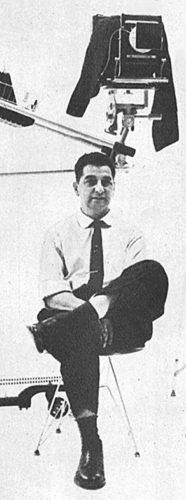
Peter James Samerjan - A name that you don't hear very often these days, Peter James Samerjan was a highly respected Hollywood photographer in the 1940s, 50s and 60s. He helped to introduce the use of nude glamour into the field of advertising photography in the 1950s. Although he worked mainly as a fashion and advertising illustrator, he also became known for his pin-ups and beach glamour, with many of his photos appearing on the covers of photography magazines during the 1940s and 50s. His beach pin-ups appeared quite frequently in U.S. Camera beginning in 1950 or so, and his nudes were featured in publications such as Figure Photography Annual. Of the acceptance of nudity in 1950s advertising, Samerjan once remarked: "This revolution in cheesecake is a natural and encouraging growth in the taste of the American public which becomes more sophisticated as it becomes accustomed to new things."
Concerning Samerjan's pin-up work, fellow Hollywood photographer Danny Rouzer opined in 1956: "Peter James Samerjan is one of the most creditable pin-up cameramen in the business today. Samerjan has developed the field of pin-up photography to where it is a definite challenge to other photographers from several standpoints. Samerjan is indeed a craftsman because even though his picture might be thought unorthodox, the expression on his model's face many times sells the picture. He knows how to capture many different moods in a model."
Samerjan was born in Boston on Sept. 6, 1917 and at two years of age his family moved to Los Angeles. As a youngster, his ambition was to become a fine artist, and he would later attend the Art Center School in Los Angeles. In his late teens, he had occasion to watch a photographer at work and it impressed him so much that he got a hold of a small camera and began taking pictures. At that point, photography became his life and ambition. In 1946 he opened his own studio in Hollywood and became primarily interested in women's fashion photography, but also dabbled in candid portraits, scenics, and documentary work. However, he believed that fashions and women's products offered more creative possibilities for him as a photographer, and he began to specialize in glamour-type cheescake for advertising illustrations.
Camera equipment used by Samerjan was an 8x10 Deardorff camera with a 14 inch Commercial Ektar lens for color work. Most of his agency black and white work was done on a 5x7 Agfa View camera. He used a Linhof for 4x5 color but for most of his glamour and candid work he relied on the Rolleiflex or a Leica (35mm).

Peter married his girl friday, Marion, who handled the office, booked the models, supervised make-up, and located props and accessories.
Some of Samerjan's models included popular Hollywood model Joann Arnold, as well as Jayne Mansfield, June Blair, Dorothy Martinson, Barbara Drake, Jane Easton, Doris Gohlke, Vikki Dougan, Barbara Johnson, Abby Dalton, Maila Nurmi, Jackie Waldron, Mona Knox and Phyllis Applegate.
Mr. Samerjan also became known for shooting jazz album covers in the 50s and 60s as well as some pop/rock album covers, such as Chad and Jeremy's 1966 album Distant Shores. He also shot some covers for TV Guide.
Peter James Samerjan passed away on Jan. 22, 2006, in Las Vegas. He was 88 years old.
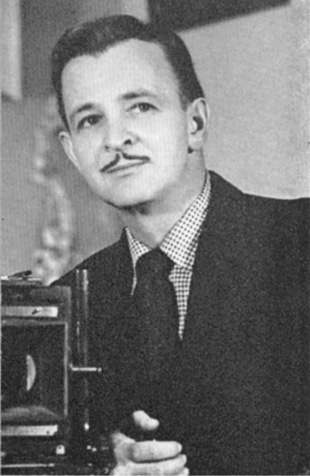
Keith Bernard - If you read my profile on Bruno Bernard, you saw that Bruno sold his Bernard of Hollywood studios to his assistants in 1952 and moved to Las Vegas in '54 to set up a studio on the top floor of the Riviera Hotel. The assistant who bought his Hollywood studio was a man who would later become known as Keith Bernard. In one sense, he was a bit of a mysterious man, as he had changed his last name to Bernard to match the name of the studio. If anyone reading this knows his real name, please let me know. Update: Photographer Michael LeRoy, who shot glamour for a while in the early 60s, and who apprenticed with Keith Bernard, says that Keith's real name was Keith Davis. By the way, Mr. LeRoy took some excellent photos of Gloria Dawn (see my Glamour Models page for info on how you can order photos from her).
Keith "Bernard" was born and raised near Lake Taneycomo in Missouri and developed an appreciation for beauty early in life. While in high school he began working as a traveling commercial photographer for R.H. Overton Company during his summer vacations. He traveled through 46 states plus Canada and Mexico. He had originally been intent on becoming a civil engineer, but his photographic work won out and he eventually quit school to become a photographer. He moved to Portland Oregon and became manager of the photo studio in the Meier and Frank department store. After 5 years he opened his own studio in Bellingham, Washington and then moved to Seattle to purchase that city's leading studio (Grady Studio). He expanded this into a small chain that was quite successful until he tired of it. "I suppose Hollywood was always alluring to me", he said. "One day I decided to sell everything and go to California - which I did, quite on the spur of the moment." For one year, he took a break from photography and lived in Malibu before gaining employment with Bruno Bernard's Palm Springs studio. When Bruno decided to sell all of his California studios a few years later, Keith was left with the Hollywood studio and the rights to call himself Bernard of Hollywood. To appear more authentic, he changed his last name to Bernard, as mentioned above.
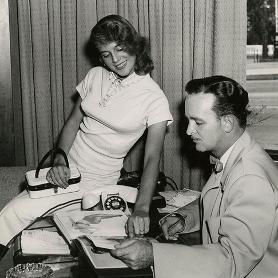
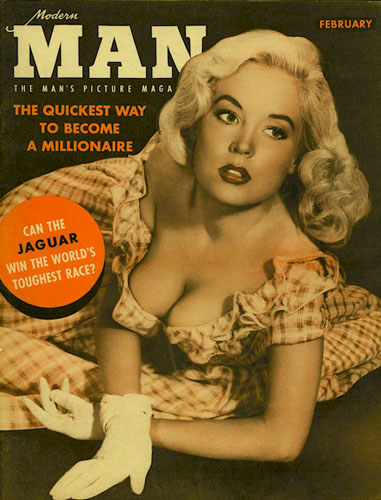

Although Keith never photographed a centerfold for Playboy magazine, he did contribute two of his photos of Jayne Mansfield to the Nov. 1957 pictorial entitled Loren vs. Mansfield.
For his studio work in the 1950s, Keith used a 5x7 view camera with a portrait lens, and for outdoor work, he used two cameras - a 4x5 Speed Graphic and a Rolleiflex. He admitted to being a little slow in switching to the medium format Rollei, but he came to use it as much or more than the 4x5. By the 60s, he was using the Rolleiflex for B&W work and a Hasselblad for his limited outdoor color work.
In 1963, Keith Bernard was quoted as saying "I enjoy my work and expect to continue at it for a number of years to come. If others enjoy it, then I am happy and proud. That is enough success for me."
Keith continued to have his figure photography published in magazines up until at least 1976, with portfolios of his work appearing in Figure Photography Quarterly in both the Fall of 1966 and Winter of 1976 issues.
Update #2: One of Keith's grandchildren, Keith W. Davis (Keith W. Davis Photography) tells me that Keith Bernard's full birth name was Marion Keith Davis. He was born on July 25, 1911 in Ozark, Missouri and died on April 8, 1981 in Los Angeles. Keith had been married at least three times, and was known to have had four children, a son and a daughter from both his first and third unions (David Keith Davis and Mary Kathryn Davis by his first wife and Keith David Davis and Leslie Davis from his third marriage. Both sons are now deceased). Update #3 (8/4/22): I have only just discovered that Keith W. Davis, who gave me information about his grandfather Marion Keith Davis in Update #2, passed away on May 21, 2021. He was 69 years old (the same age his grandfather was when he died).
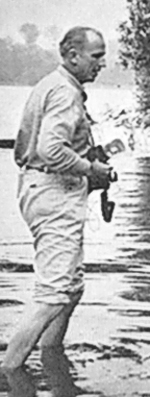
Bill Hamilton - Bill Hamilton was another photographer from the Miami area and a contemporary of Bunny Yeager. As such, some of the well known models who were photographed by Bunny Yeager, also worked with Bill Hamilton. These models included Virginia Remo, Alta Whipple, Lana Bashama, Gigi Reynolds, Cindy Fuller, Maria Stinger and Bettie Page. It was Hamilton who first discovered Maria Stinger and recommended her to Bunny Yeager, which resulted in Bunny's first photo sale and magazine cover. Of working with Bettie Page, Hamilton once wrote: "Bettie is a very unselfish girl and will go out of her way to give a photographer the pictures that he is trying to produce. If you are not getting results, then the fault is yours and not this lovely model's."
A few other models who worked with Bill Hamilton include: Yvette Meyneau, Sonja Carlsen, Jeannette Lee, Mona Winther, Annette Casir, Nina Morini, Sharon Lee and Monica Eberlin.
Bill Hamilton first got the idea that photographing women might be a pleasant hobby when he witnessed his first Miss America pageant in Atlantic City in 1938. In those days he was just messing around with a Kodak Brownie, but he was soon able to pick up a Rolleiflex. In 1942, he joined the U.S. Navy and saw service as a photographer all over the world in Navy Intelligence and also as a member of Combat Photo Unit 10 of Naval Public Relations. After the war, he received an honourable discharge and went to work in Europe where he met his Danish wife Hildi. With her help, he was able to find fresh and talented models to photograph. During the photo shoots, Hildi became his first camera assistant, film changer, and also helped to select the model's wardrobe. She was the only person he allowed to be at the photo shoot with him. Another individual who helped his career was Bill Prange, an agent who taught Hamilton how to make photos that would sell.
After Mr. Hamilton sold his first nude photo in 1954, he decided to specialize in figure photography and sold his photos to a wide variety of publications including Figure Annual and men's magazines such as Modern Man and Rogue. A book entitled Bill Hamilton's Lens Magic was published in 1963 which featured "more than 200 art studies of elegant figure beauty". Whitestone also published one book of Hamilton's glamour photos - Bill Hamilton Photographs World Beauties (1965).
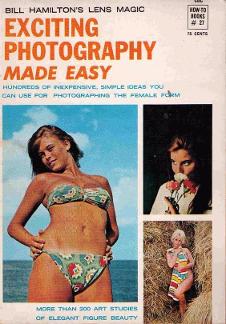
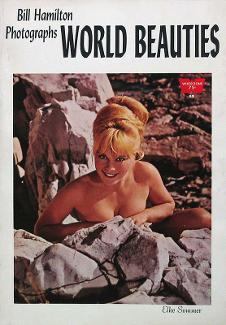
Camera equipment used by Bill Hamilton included the ubiquitous Rolleiflex, as well as the Leica M3 (35mm) and the 4x5 Speed Graphic, which he used for his various advertising and magazine jobs. Of his Rolleiflex, he wrote: "For me, it is the best camera in all the world. Using it for 20 years as a photographer, it has never failed."
Concerning his work as a glamour and figure photographer, Bill commented: "There is a great deal of satisfaction to be gotten from the knowledge of a job well done - a beautiful picture created and given to all to enjoy."

Bill and Melba Figge, a couple who started shooting weddings and went on to have their superb photography featured in the pages of Playboy magazine.
William Figge - Bill Figge was another excellent photographer who shot for Playboy magazine. He photographed a total of 28 Playmates from 1965 to 1976, but for the years we're considering here (the 60s), he photographed 16 Playmates, with 12 of them being shot with Edward Delong as a collaborator. Figge photographed four Playmates from the 60s on his own or with his wife Melba. They are: the beautiful Allison Parks (who we tragically lost in June 2010 of heart failure while she was vacationing in Hawaii), Kelly Burke, Gaye Rennie, and Dru Hart.
William Figge (pronounced "figgy") was born on March 25, 1919. By the 1940s, Bill was a cinematography student at USC, but enlisted in the army and went to war as a combat photographer. He was the first American photographer to witness Russian troops as they rampaged through Berlin and was also the first American photographer to enter Hitler's bunker in Berlin. Upon returning to the states at age 26, he reunited with Melba Lacayo, a young woman he met at USC before going off to war and the two were soon married. Unable to find work in cinematography, Bill and Melba set up a photography studio in their garage in Culver City and began doing freelance wedding work in 1947. They'd show up at a wedding unannounced, photograph the ceremony and reception and then leave a calling card with the couple. The newlyweds would eventually call and look through the photos and the Figges would make some photo sales, and soon gained an excellent reputation in the area. Within five years, Bill, Melba, and a growing team of photographers under their supervision were shooting five hundred weddings a year.
In 1963, at age 44, Bill decided to see if he could get his work in Playboy. He photographed Sue Williams, who was the sister of a young woman who worked in his studio (which was by now located in Glendale). According to Melba: "We sent the first one in...and Hugh Hefner said "She's really cute. We'd like to see your work.", so we said "Fine" and did some more cute pictures of her. They loved our work and pretty soon they added our names to the magazine as contributors because we didn't want to be part of their staff."
In one particular ten month period (July 1967 to April 1968), the Figges photographed an incredible six Playmates of the Month and one Playmate of the Year pictorial.
As mentioned earlier, Bill Figge photographed 16 Playmates during the 1960s as well as two Playmate of the Year pictorials (*denotes when Ed Delong was credited as a collaborator):
Sue Williams (Miss April 1965)*
Maria McBane (Miss May 1965)*
Allison Parks (Miss October 1965)
1966 Playmate of the Year - Allison Parks
Kelly Burke (Miss June 1966)
Tish Howard (Miss July 1966)*
Lisa Baker (Miss November 1966)*
Heather Ryan (Miss July 1967)*
1967 Playmate of the Year - Lisa Baker
Kaya Christian (Miss November 1967)*
Lynn Winchell (Miss December 1967)*
Nancy Harwood (Miss February 1968)*
Michelle Hamilton (Miss March 1968)*
Gaye Rennie (MIss April 1968)
Dru Hart (Miss September 1968)
Lorrie Menconi (Miss February 1969)*
Lorna Hopper (Miss April 1969)*
Nancy McNeil (Miss July 1969)*
In the case of Michelle Hamilton (Miss March 1968), it was Michelle's mother who actually called the Figges (who she had heard about from a local dental technician) and made an appointment for her daughter to do a test shoot. The mother of Gaye Rennie (Miss April 1968) had already known Mel Figge for years. When her daughter was asked to pose, she and her husband were a little hesitant at first, but once they saw the beautiful test photos, Gaye's mother gave her consent. "If it had been any other photographers, we wouldn't have agreed to it", she said, "But the Figges are friends."
Their last Playmate of the 60s, Nancy McNeil was discovered by Bill when he noticed her in a wedding party he was shooting. According to one report, he found a few of his Playmates this way.
Bill Figge would photograph 12 more Playmates in the early 70s. On May 24, 1976, he died suddenly of cancer. He was 57 years old. His family continued the studio and moved it to Newport Beach, where it remains today under the ownership of two of his four children (son Greg and daughter Leslie). Another son, Eric, became an accomplished architectural photographer.
Researching glamour photographers sometimes brings up little mysteries, and as I'm someone with an insatiable curiosity, it's a little frustrating for me at times (at least until the mystery is solved). One of the mysteries I'm pondering here is that Bill Figge is credited with photographing Michelle Drake, Miss May 1979, but this pictorial appeared in the magazine a full three years after Bill passed away. So I'm wondering if it took three years for Hef to approve the layout or if Melba photographed Miss Drake on her own. More research is needed, I guess.
I have to say that the Figges' work was just amazing and several of their centerfolds are among my all time favorites. One of them, Miss December 1967 Lynn Winchell, is a particular sentimental favorite of mine.
Update: Melba Figge passed away on January 21, 2015, surrounded by her family. She was 92 years old.
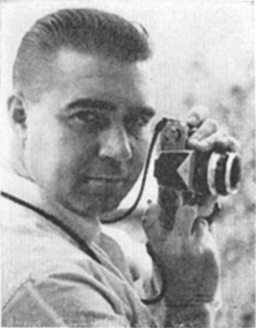
Edward DeLong - Edward DeLong was another photographer who shot some of the classic Playboy images from the 50s, the 1960s and early 70s. What's a little unusual is that he usually worked in collaboration with another photographer when photographing Playboy Playmates. Why two photographers would need to work together is a little bit of a mystery to me, and it does make me wonder what each individual photographer brought to the table.
Edward DeLong's first centerfold for Playboy magazine was of Arline Hunter (Miss August 1954). Miss Hunter was said to have had a striking resemblance to Marilyn Monroe and DeLong's pinup of her seemed to have been influenced by Marilyn's centerfold from that very first issue of Playboy magazine (Dec. 1953).
DeLong then collaborated with David Sutton in the late 50s and the two were credited with shooting the pictorials and centerfolds for:
Sally Todd (Miss Feb. 1957)
Dawn Richard (Miss May 1957)
Beginning in the mid 60s, his new collaborator became William V. Figge (Bill Figge) and together they photographed 12 Playboy Playmates during the 1960s and four more during the early 70s. The 1960s Playmates they are credited with photographing are:
Sue Williams (Miss April 1965)
Maria McBane (Miss May 1965)
Tish Howard (Miss July 1966)
Lisa Baker (Miss Nov. 1966)
Heather Ryan (Miss July 1967)
Kaya Christian (Miss Nov. 1967)
Lynn Winchell (Miss Dec. 1967)
Nancy Harwood (Miss Feb. 1968)
Michelle Hamilton (Miss March 1968)
Lorrie Menconi (Miss Feb. 1969)
Lorna Hopper (Miss April 1969)
Nancy McNeil (Miss July 1969)
Like a few other west coast glamour photographers, Edward DeLong originally received his photographic training from the Art Center School in Los Angeles. He became a professional photographer in 1946 as assistant to John Rudolph and eventually opened a studio of his own in Burbank. In 1949, he began shooting glamour photos for magazines and had hundreds of models come through his studio in the 1950s. Some of his models from that time include: Carmen Phillips, Andrea Cleall, Tanya Mann, Pat Conley, Tracy Morgan, Joan Bradshaw, Barbara Thomason, Jean Patton, Virginia DeLee, Betty Hansen, Madelyn Darrow, Vikki Dougan, Dawn Richard, Diane Webber and Joan Castle.
DeLong's prefered camera equipment included a Rolleiflex and a Hasselblad for medium format and the Nikon F and an Asahi Pentax for 35mm. He generally used two types of B&W film for his cameras - Gevaert Dandi Pan for medium speed film and Kodak Tri-X, which he rated at ASA 500. For his film developer, he prefered to use D-23.
Update (March 6, 2018): In a response to my inquiry to Figge Studio, I learned that Edward DeLong is still alive and living in Los Angeles. He is 93 years old. He pretty much retired from glamour photography about the same time Melba Figge told Hef she would retire, as she "was not a gynecologist!"
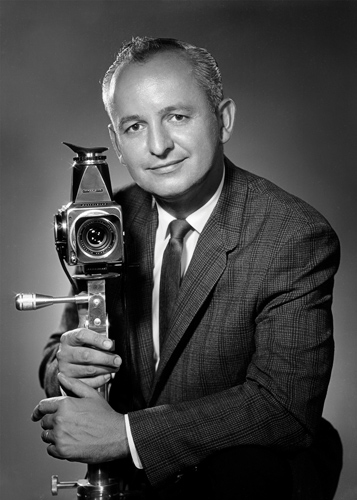
Portrait courtesy of Chester Leja (Edmund's brother) and graciously provided to this site by Tom Leja
Edmund Leja - Edmund Leja was born in Detroit, Michigan on Nov. 7, 1919. In 1943, he earned a degree in Chemical Engineering (with a minor in Mechanical Engineering) from Lawrence Institute of Technology, and soon after graduating, he enlisted in the Navy. After undergoing officer training at Columbia University in New York City and also in Florida, he was commissioned to Okinawa, Japan where he was assigned the tasks of rebuilding the water systems and a fishing port after the end of WWII. Re-entering civilian life in 1946 (though he remained in the Naval Reserves and eventually retired with the rank of Lieutenant), Edmund Leja returned to Detroit and landed a job with Chrysler Corporation as a tool-and-die engineer for Dodge cars. While working for Chrysler, he attended night classes in photography and fine art and a year or two later opened Collier's Photography Studio in Detroit. After four more years of working full time for Chrysler and also operating the photo studio during nights and weekends, Edmund got the bug to move to Southern California and sold the studio to his brother Chester, who ran it for another 10 years.
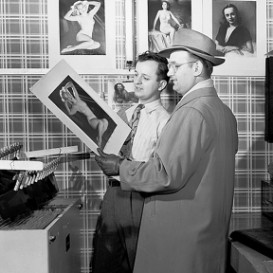
Edmund Leja in the darkroom of Collier's Photography Studio in Detroit, Michigan (circa 1950) showing some of his pin-up work to a customer. Photo courtesy of Tom Leja
Upon his arrival in California in 1952, Leja once again secured work as an engineer, but this time in the aviation industry, working on the Lockheed Constellation and Electra airliners. With buying his first home, getting settled in California and raising a family, Edmund initially had less time to pursue his photography. In the mid 1950s, he began working for Rocketdyne, a leader in the aerospace industry, and eventually moved to Woodland Hills, CA. It was at this time that he increased his activity in photography and began hiring models on weekends to shoot on location and in and around his home. For his artistic figure work, Leja often preferred the great outdoors, just like one of his colleagues, Andre de Dienes. Based in West Hollywood and Studio City, at the heart of the early Southern California nude photography industry, de Dienes and Leja shared several model contacts. They both photographed two-time Playmate of the Month Diane Webber (Miss May 1955 and Miss February 1956), Colette Berne (Playboy cover model, July 1960), as well as Sue Snow and Tammy Saunders. Some of Leja's other models included Madeline Castle, Pat Connely, Goldie Gibson, Kellie Everts, Brigette Baum, Mickey Jines, Gigi Frost, Shirley Kilpatrick, Keli Stewart, Wendy Wyatt, Palva Itano, Shirley Skates and Cecile Allain.
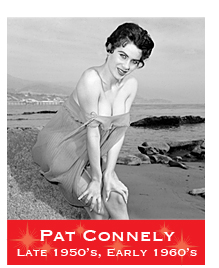

Photos courtesy of EdmundLejaVintageNudes.com
Very quickly, Leja's nudes began to be recognized by magazine editors and his images would appear in men's magazines and several photography periodicals, including Good Photography, Salon Photography and Prize Winning Photography. In the early 60s, having gained great success with his photography, Edmund concluded his engineering career and moved to Studio City, CA and pursued glamour photography and magazine editing/design full time for most of the rest of his life.
Leja discovered and photographed three Playmates for Playboy magazine (one of these Playmates, Donna Michelle, had actually been discovered by one of Leja's daughters). He photographed Teddi Smith, Miss July 1960, Donna Michelle, Miss December 1963 (and 1964's Playmate of the Year), and Lori Winston, Miss June 1964. Because Playboy was hesitant to have a first time photographer for the magazine shoot Teddi Smith's centerfold, they hired William Graham to take on the task. This centerfold was shot on board a motor yacht in either Port of Los Angeles or Port of Long Beach, with Edmund also in attendance. Most of the other color images of Teddi Smith that you'll find on the internet were shot by Leja, who photographed her at his home in Woodland Hills as well as locations around LA. For Leja's second Playmate, Donna Michelle, the more experienced Playboy photographer Pompeo Posar was hired to shoot the centerfold, with Leja contributing the other color image to the layout, as well as all of the b&w photos. In this same Dec. 1963 issue, Donna Michelle makes another appearance in a feature entitled "Editors' Choice - ten personal favorites from playboy's first ten years" and all three color photographs of her presented there were by Edmund Leja. Some other excellent Leja color images of Donna Michelle have appeared in various Playboy special features over the years. For his third Playmate, Lori Winston, Edmund photographed the entire pictorial including the centerfold. This beautiful Playmate centerfold was shot in the living room of Leja's new Studio City home, with Tom Leja, Edmund's son, assisting with the setup and props.
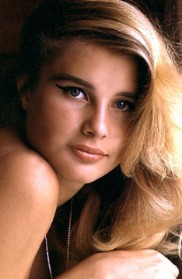
Two images of Playboy's Playmate of the Month for December 1963, Donna Michelle, that were shot by Edmund Leja in his Studio City home. Donna had been discovered by one of Leja's daughters.
Like most glamour photographers from the 50s, Mr. Leja's camera equipment evolved over time, with the trend going towards the smaller formats. In Michigan, he used mostly 4x5 large format view cameras (some 5x7) and rangefinder medium format press cameras. After he moved to California, he initially used the twin lens reflex Rolleiflex, then switched to the Mamiyaflex C2 to take advantage of interchangeable lenses. In the early 60s he switched to the Hasselblad and occasionally shot with Nikon F 35mm cameras. He rarely used his 4x5 cameras at this time and would rent an 8x10 camera when needed. For film, he was not a big fan of high speed B&W because he knew how to light a scene artificially. He primarily used Plus-X Pan for B&W because of its fine grain and Ektachrome for his color work.
A leading pioneer in the fields of glamour, pin-ups, nudes and erotica, Edmund Leja photographed over 200 models between the 1940s and the early 1980s. His body of work encompasses more than 100,000 images. As a testament to the quality of Leja's work, in 1965 Andre de Dienes gave Leja a copy of his new book, Sun-Warmed Nudes with the inscription, "Dear Ed, perhaps someday you will want to publish a much better one! Best wishes, Andre de Dienes."
Edmund Leja died at the age of 83 on December 19, 2002 at a Hospice in Las Vegas, Nevada. He was given the last rights by a Catholic Bishop and was buried at Riverside National Cemetery in California with a Memorial Honor Detail and a rifle salute.
A tribute to Leja's work has now been created by his son Tom, in the form of a member website. This site, EdmundLejaVintageNudes.com has a Free Tour gallery and the models can also be viewed for free as thumbnails in the Main Gallery. In the future, Tom hopes to offer fine art prints as well as publish books of his father's photography, so I hope the readers of this site will be on the lookout for these great collectibles. Update (1/6/22): Tom had to take down his website in 2017 due to it being hacked several times. The hosting company informed him that he needed to rewrite the code to prevent further attacks and Tom didn't feel it was feasible so he reluctantly shut the site down.


William Graham - William Graham was born in Martinez, CA on June 14, 1915. Graham was another graduate of the Art Center School of Los Angeles, where Ansel Adams was one of his instructors. After graduation, he initially entered the commercial photography field but soon learned that magazine layout work was more to his liking. At his Hollywood studio he had many young women who were seeking careers in the movie capital knocking on his door for pictures. Although he used his studio for many test shots, Graham transferred most of his shooting to the outdoors where he found the backgrounds to be unlimited. He preferred to do all-day shoots instead of the usual two to four hour sessions so that he could work at a pace that he felt gave him the most in creative ability. Often, he would shoot as many as 500 photos of a model in a couple dozen locations during one of these all-day shooting sessions. Some of his glamour models included Diane Webber, Judy Bamber (Caper, Sept. 1959), Joyce Winfield, Lynn Dumant, Dori Stevens, Dana Craig, Nicki Gibson, Virginia DeLee, Cathy Crowfoot, Brigitte Baum, and Paula Angelos.
William Graham photographed layouts for several men's magazines and shot cover photos for some of them as well. Below are a few of the covers that he photographed for the magazines Escapade and Caper.



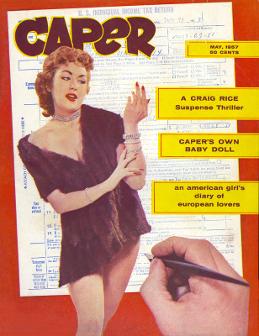
One of William Graham's discoveries turned out to be a young woman who would later become Playboy's Miss December of 1959, Ellen Stratton. Graham and his wife Shirley had spied Miss Stratton while she was having lunch in a restaurant across from the Hollywood law office where she worked as a secretary. Shirley approached her and asked if she would do some test shots for modeling. She agreed, and after the shoot, William asked her if he could submit her photos to Playboy as a Playmate of the Month candidate. At first, she said no, but shortly afterward she changed her mind, not thinking anything would come of it. However, Hugh Hefner soon called and Ellen was quite surprised. She met with Hef to discuss becoming a Playmate, and once she agreed, William Graham photographed her layout, including the classic centerfold. Ellen Stratton later went on to become the first Playmate of the Year and William Graham also photographed that pictorial, which appeared in the June 1960 issue of the magazine.
The month after Ellen Stratton's PMOY pictorial appeared in the magazine, Graham's centerfold shot of Teddi Smith, Miss July 1960, also graced the pages of Playboy (see above profile of Edmund Leja for more details on the shoot). Below is a photo of William Graham on the set of Teddi Smith's centerfold shoot. This image was shot by Edmund Leja who had discovered Miss Smith and did her non-gatefold photography.
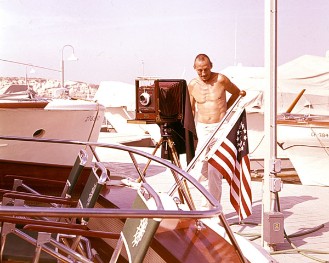
Photo of William Graham courtesy of Edmund Leja/ Leja Art
Graham's next Playmate was Carol Eden, Miss December 1960. A little bit of trivia about Carol Eden was that she was the first Playmate to have a daughter who would also become a Playmate (Simone Eden, Miss Feb. 1989).
The fourth and last Playboy Playmate that William Graham photographed was Linda Moon, Miss Oct. 1966. In this case, he did some of her non-gatefold photography, with Stan Malinowski shooting the centerfold.
Also in 1966, William Graham published a book of nudes entitled "What is a Woman?". Another somewhat more obscure book followed: "The Illustrated Kama Sutra".
William Graham passed away on November 30, 1991 at his home in Kihei, Maui, Hawaii. He was 76 years old.
Special thanks to his son Shawn (and also to his niece Penny) for some of the biographical details included in this profile!
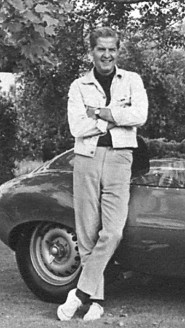
Carlyle Blackwell - Born on May 22, 1913 in Glendale, California, Carlyle Blackwell Jr. had a lot in common with Peter Gowland. They were both the sons of silent film stars (Carlyle Blackwell and Gibson Gowland), they both became actors themselves, and both also had a keen interest in photography. With Peter and Carlyle playing bit parts in movies at the same time, it was natural that they would become friends, and along with other actors who were also into photography, they formed a camera club that they called the "Hollywood Camera Clique". While Peter Gowland's early camera preference was the medium format Rolleiflex, because of its relatively large negative, Carlyle's initial choice was a 35mm rangefinder Leica, because of the faster lenses and the ability to use different focal length lenses on the camera.
Like Gowland, Carlyle also had a flair for glamour photography and became a professional photographer who would on occasion photograph beautiful Hollywood actresses and models. He was one of the photographers who would photograph Marilyn Monroe in the early 50s (it has been said that one of Gowland's few regrets was that he never got to photograph MM) and he also shot the pin-up of Jackie Rainbow that would put her in the centerfold of the September 1954 issue of Playboy.
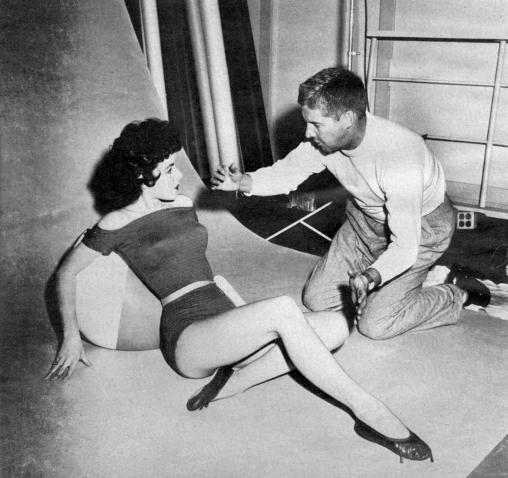
While Carlyle would go on to shoot glamorous gals for various other men's magazines, including Modern Man and Rogue,
he became even better known as one of the best automotive photographers
in the U.S.. Carlyle did a lot of photographic work for Road and Track
magazine in particular, including many covers. Not
only was Mr. Blackwell an automotive photographer, he was also a
devoted British sports car enthusiast and raced cars himself. He won at
least 35 trophies in his Jaguar D-Type and also served on the Board of
Governors of the California Sports Car Club in the late 50s and 1960s.
Carlyle
Blackwell's photographic career began in earnest in 1937 when he won a
salon contest in Germany, with a figure study that he later regarded as
one of his best. His work after that was mainly in advertising and
magazine covers, but he still photographed girls "for fun". Some of
Blackwell's all-time favorite models that he photographed during the
1960s include Lynn Sherman, Pat Barbeau, Laura Drew, and Marli Renfro
(also a favorite Gowland model).
Married
to actress Julie Cabanne since May of 1939, Carlyle had two children -
one son and one daughter. Carlyle Blackwell Jr. died on September 20,
1974 in Hollywood, California at the very young age of 61.
Update (12/29/21): I was very sad to learn that Carlyle Blackwell's daughter Pamela passed away in June of 2017 at the age of 73. We exchanged a few emails after she sent me a nice message about her father's profile on this site in 2012. I last heard from Pamela in March 2017 after I sent her a pdf file of a Modern Man article about her father. Both her mother and brother preceded her in death. Her brother died in 2008 and her mother passed away in 2010 at the age of 95. You can read Pamela's obituary here.
Below are some of Carlyle Blackwell's photos of Marilyn Monroe.

Art Messick prepares for a photo shoot with figure model Marilyn Wesley for a feature article to be published in the Winter 1959 issue of Figure Quarterly. Miss Wesley, a native Alaskan, is shown filling out her vital statistics for the photographer's files.
Art Messick - Arthur Messick was another Hollywood photographer from the early 40s through 1960 who did his fair share of glamour work. Messick was born on Sept. 9, 1921, and while still in his early 20s, was brought from Tucson, Arizona to Hollywood by Kodak, as they were eager to learn how he was able to achieve such beautiful skin tones when shooting Kodachrome transparencies. While in Hollywood, Art Messick sought out and later shared a studio with Laszlo Willinger, a well respected photographer who shot numerous magazine covers. Art gained a name for himself in the movie industry by photographing many of the top stars of the time, including Fred Astaire, Bing Crosby, Rita Hayworth, Jayne Mansfield, Ronald Reagan, Boris Karloff and hundreds of others. He also became a stringer for Life Magazine, Encyclopedia Brittanica and Family Circle.
By the early 50s, Mr. Messick's work became increasingly prominent in the calendar, album cover and magazine fields and he soon became more involved with glamour and figure photography. It has been widely reported that the television series "The Bob Cummings Show" (retitled "Love That Bob" for syndication) was inspired by Art's life. The show about a playboy/photographer ran from Jan. 1955 to July 1959, and during this same time period, Art continued to contribute his nude glamour photos to men's magazines and photo publications such as Modern Man, Adam, Sir Knight and Figure Quarterly. Some of Messick's models included Sandra Edwards, Paula Shaw, Judy Crowder, Bambi Hamilton, Shirley Skates, Allyson Sanborn, Nancy White, Madeline Castle, Vivian Maledy, Yvonne Meyers, Shirley Kilpatrick, Brigitte Baum, Colette Berne, Glenda Graham, Dena Scott, Betty MacGowan, and Marilyn Wesley.

Art Messick shot this cover photo of Sandra Edwards for the May 1958 issue of Modern Man. I was so struck by the style and pose of this photo that I originally assumed it was the work of Peter Gowland.
In 1960, Mr. Messick moved to Paris, France and opened a studio there and later for a short time in Copenhagen, Denmark. In 1966, Art suffered from blindness that was blamed on his use of arc lamps in some of his earliest photography jobs. The high UV content of these lights was said to have damaged his retinas. Art returned to Los Angeles in 1970 and was later selected for an experimental procedure at the Jules Stein Eye Institute at UCLA, and the operation miraculously restored his eyesight! Art then opened a studio in Santa Monica in 1972 and ran that operation until 1980, when he retired to Oahu, Hawaii. When his eyesight began to again fail, he moved back to the mainland around 1999 and lived in Aloha, Oregon, and later, for a year in Reno, Nevada.
Art Messick passed away on July 13, 2007, at the age of 85. Messick had been married and divorced five times, but had no children.
Update/Correction (12/26/20): Mr. Jeff Turner wrote to let me know that his wife Jennifer has found proof through a 23&Me genetic match and other research that his father Michael Adrian Turner was Art Messick's child by his first wife, Barbara (McClendon) Messick. The two were married on Oct. 6, 1940 when Art was 19 years old. Barbara gave birth to Michael Messick on Feb. 17, 1943, but Art always denied that he was the father (hence the need for genetic testing). After Arthur and Barbara were divorced some five months later, Michael was raised by Barbara's parents until he was four years old. Then, Barbara re-entered the picture with a Mr. Turner and Michael took his last name. Michael later had three children (Jeff Turner among them) and combined; those three siblings had 11 children. So, Art Messick had one son, three grandchildren and 11 great-grandchildren (15 descendants at the time of this writing).